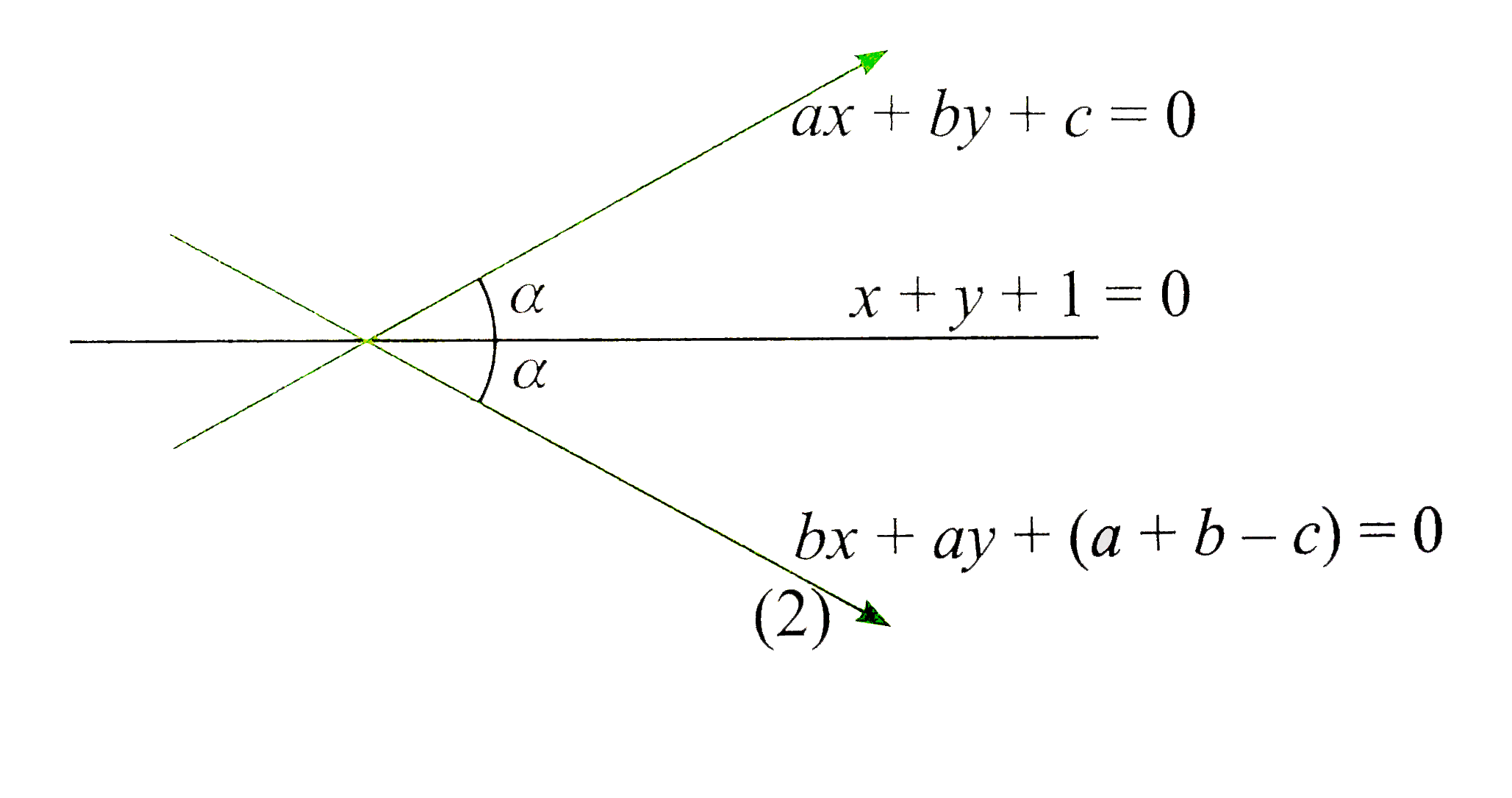Show that the reflection of the line ax+by+c=0 on the line x+y+1=0 is the line b+ay+(a+b−c)=0 where a≠b.Solution in Tamil

We have lines
ax+by+c=0 (1)
x+y+1=0 (2)
bx+ay+(a+b−c)=0 (3)
Equations of angle bisectors of (1) and (3) are
|ax+by+c|√a2+b2=|bx+ay+a+b−c|√a2+b2
or ax+by+c=±(bx+ay+a+b−c)
or x+y+1 =0 and (a-b)x+(b-a)y =a+b-2c
Since x+y+1= 0 is one of the bisectors of lines (1) and (3), reflection of line (1) in line (2) is line (3).
Topper's Solved these Questions
- BOOK - CENGAGECHAPTER - STRAIGHT LINESEXERCISE - Exercise 2.65videos
STRAIGHT LINES
- BOOK - CENGAGECHAPTER - STRAIGHT LINESEXERCISE - Exercise (Single)82videos
STRAIGHT LINES
- BOOK - CENGAGECHAPTER - STRAIGHT LINESEXERCISE - Exercise 2.48videos
STRAIGHT LINES
- BOOK - CENGAGECHAPTER - STRAIGHT LINEEXERCISE - Multiple Correct Answers Type8videos
STRAIGHT LINE
- BOOK - CENGAGECHAPTER - THEORY OF EQUATIONSEXERCISE - JEE Advanced Previous Year9videos
THEORY OF EQUATIONS
Similar Questions
If aandb are two arbitrary constants, then prove that the straight line (a−2b)x+(a+3b)y+3a+4b=0 will pass through a fixed point. Find that point.
04:33View SolutionFind the equations of the diagonals of the square formed by the lines x=o,y=0,x=1andy=1.
07:28View SolutionThe point (8,−9) with respect to the lines 2x+3y−4=0 and 6x+9y+8=0 lies on the same side of the lines the different sides of the line one of the line none of these
04:50View SolutionThe point P(α,α+1) will lie inside the triangle whose vertices are A(0,3),B(−2,0) and C(6,1) if
04:52View SolutionQ. Let p and q real number such that p≠0,p2≠q and p2≠−q. if α and β are non-zero complex number satisfying α+β=−p and α3+β3=q, then a quadratic equation having αβ and βα as its roots is
06:15View SolutionShow that the reflection of the line ax+by+c=0 on the line x+y+1=0 is the line b+ay+(a+b−c)=0 where a≠b.
07:16View SolutionIf the lines x+ay+a=0, bx+y+b=0 and cx+cy+1=0 are concurrent, then write the value of 2abc−ab−bc−ca.
07:03View SolutionShow that the straight lines (a−b)x+(b−c)y=c−a,(b−c)x+(c−a)y=a−b and (c−a)x+(a−b)y=b−c are concurrent.
02:56View SolutionIf (x, y) is any point on the line joining the points A(a, 0) and B (0, b), then show that xa+yb=1
04:13View SolutionShow that the reflection of the line ax+by+c=0 on the line x+y+1=0 is the line b+ay+(a+b−c)=0 where a≠b.
02:38View SolutionShow that the reflection of the line ax+by+c=0 on the line x+y+1=0 is the line bx+ay+(a+b−c)=0 where a≠b.
02:57View SolutionIf the lines ax+y+1=0,x+by+1=0 and x+y+c=0 are concurrent (a≠b≠c≠1) , prove that 11−a+11−b+11−c=1 .
02:48View SolutionShow that the following lines are concurrent: L1=(a−b)x+(b−c)y+(c−a)=0 L2=(b−c)x+(c−a)y+(a−b)=0 L3=(c−a)x+(a−b)y+(b−c)=0
02:22View SolutionShow that the straight lines L1=(b+c)x+ay+1=0, L2=(c+a)x+by+1=0 nd L3=(a+b)x+cy+1=0 are concurrent.
03:44View SolutionIf the lines x+ay+a=0, bx+y+b=0 and cx+cy+1=0 are concurrent, then write the value of 2abc−ab−bc−ca.
06:12View SolutionIf the lines ax+12y+1=0, bx+13y+1=0 and cx+14y+1=0 are concurrent, then a,b,c are in a. H.P. b. G.P. c. A.P. d. none of these
02:48View Solution

